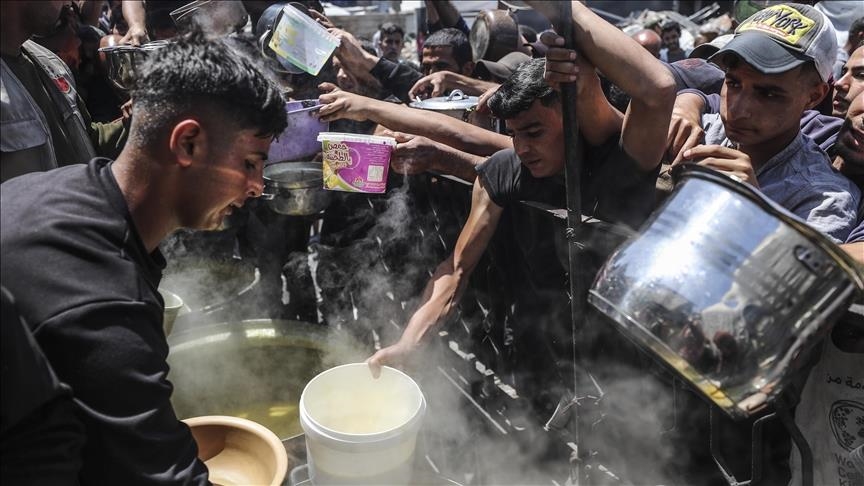INTERVIEW ŌĆ� Gaza facing critical hunger as Israel blocks aid and decimates local agriculture: Expert
Nearly 300 million people experienced acute food insecurity in 2024, with 95% of those facing catastrophic levels found in Gaza and Sudan, according to the Global Report on Food Crises 2025

- ‘It’s almost impossible for the local community to maintain any local food production at this point in time ... that’s why it’s absolutely essential that humanitarian assistance is reopened for Gaza,’ warns Conor Elliott, team leader at the Global Network Against Food Crises
- ‘About 80% of the people acutely food insecure every year are in the same areas ... That tells us we’re not solving it,’ says Elliott
GENEVA
Palestinians in Gaza are at a critical risk of full-blown famine as Israel’s unrelenting war has decimated almost any capacity for local food production and its total blockade on humanitarian aid deprives the population of basics vital for survival, a leading global food security expert has warned.
“There has been such an extent of attacks on agricultural infrastructure ... that the agricultural system has largely collapsed in Gaza,” Conor Elliott, team leader at the Global Network Against Food Crises (GNAFC), told Anadolu in an interview ahead of the launch of the Global Report on Food Crises (GRFC) 2025.
“In this case, re-establishing humanitarian access is absolutely critical to maintaining food production,” he emphasized.
Since early March, Israel has placed Gaza under a complete aid blockade, with no food, fuel, or medical supplies entering the territory.
A brief ceasefire earlier this year had allowed some relief in, but it was short-lived. The Integrated Food Security Phase Classification (IPC) projected in early 2024 that “famine is imminent” in the enclave, a risk that persists as aid access has been entirely blocked.
According to the latest IPC analysis, 100% of Gaza’s population of over 2.2 million people is now experiencing high levels of acute food insecurity.
One-third of Gaza is classified as being in the “critical” nutrition phase, with no functioning routes for emergency food relief.
“It’s almost impossible for the local community to maintain any local food production at this point in time ... that’s why it’s absolutely essential that humanitarian assistance is reopened for Gaza,” Elliott warned.
Nearly 300 million people at risk of starving to death
The 2025 GRFC paints a grim picture of worsening hunger worldwide.
In 2024, a record 295.3 million people across 53 countries and territories were found to be facing high levels of acute food insecurity (IPC Phase 3 or higher), an increase of nearly 14 million over the previous year.
This marked the sixth consecutive year of worsening global hunger, with the share of the global population affected rising to 22.6% in 2024, from 21.5% in 2023.
The number of people in IPC Phase 5 – classified as catastrophe – more than doubled. People in this phase face extreme food shortages, depleted coping mechanisms, and rising levels of malnutrition and death.
Over 95% of them are located in just two places: the Gaza Strip and Sudan.
In Sudan, famine was officially confirmed in the Zamzam refugee camp in North Darfur in mid-2024, marking the first official famine declaration globally since 2020.
Four more areas later fell into famine status, with projections warning of five more. Overall, 25.6 million people in Sudan are now classified as being in “crisis or worse,” including over 8 million in IPC Phase 4, just one step below famine.
Countries like Afghanistan, Democratic Republic of the Congo, Ethiopia, Syria, and 365bet╠Õė²į┌Ž▀╩└Įń▒Ł have all consistently reported more than 5 million people in IPC Phase 3 or above every year since 2016, the GRFC found.
“One of the other key elements of the report is that about 80% of the people acutely food insecure every year are in the same areas ... year in and year out,” said Elliott.
“That tells us we’re not solving it.”
Conflict and climate main drivers of disaster
In Nigeria, the GRFC recorded the largest year-on-year increase in food insecurity, as an additional 6.9 million people were affected in 2024, bringing the national total to 31.8 million.
Conflict, inflation, and disruptions to agriculture were cited as the main drivers.
The Democratic Republic of the Congo and Bangladesh each had more than 23 million people experiencing food crisis levels.
Myanmar saw a sharp deterioration due to escalating armed conflict and environmental shocks, with 14.4 million people now affected, up by 3.7 million from the previous year.
Globally, conflict was identified as the primary driver of food insecurity in 20 countries, affecting 140 million people.
Climate extremes, ranging from droughts in southern Africa to flooding in South Asia, were the leading cause in 18 countries, impacting 96 million people.
Economic shocks, including inflation, currency collapse, and debt burdens, were the primary factor in 15 countries, affecting 59 million people.
Women and children at growing risk
The GRFC also highlighted a deepening crisis in nutrition, particularly among young children and pregnant women.
In 2024, 37.7 million children between 6-59 months in 26 crisis-affected countries were acutely malnourished. Of these, 10.2 million were suffering from severe acute malnutrition (SAM), the most life-threatening form.
Elliott noted the devastating impact this has on development and survival. “A glass of milk a day ... can provide about 50% of the calcium and magnesium, and up to 140% of Vitamin B and a whole host of other vital nutrients ... When you lose those, the nutrition impact is very profound on children.”
In addition, 10.9 million pregnant and breastfeeding women across 21 countries were found to be acutely malnourished.
As global food funding continues to decline – projected to drop by up to 45% – basic nutrition services for at least 14 million children are at risk of collapse, the report further warns.
Elliott said the humanitarian system is now being forced into painful decisions, including “downsizing” critical operations and having to choose between which geographies to target, or what type of intervention to pursue.
‘Stopping conflict is a political decision’
While emergency food aid remains essential in areas approaching famine, Elliott emphasized that long-term recovery depends on rebuilding resilient, locally-based food systems.
He stressed the need for “multi-sectoral and integrated interventions,” particularly for livelihood assistance and emergency agriculture.
“Communities that were growing and producing their own food had much less acute food insecurity than those who were reliant on humanitarian assistance,” he said.
The report also warns that displacement and data shortages are compounding the crisis, while funding shortfalls are undermining the ability to monitor hunger hotspots, making it harder to respond before famine sets in.
Elliott raised alarm about gaps in surveillance: “Without that architecture to collect the information, we’re not able to understand what’s happening in any one context ... We’re now in a situation where we don’t have funding for operational actors to gather data.”
The link between displacement and hunger was also clear.
Nearly 96 million people in GRFC-reporting countries were forcibly displaced, with displaced populations consistently found to be more vulnerable to food insecurity than their hosts.
In every country where IPC Phase 5 was recorded, displaced communities were among the most affected.
Elliott concluded with a stark message: “Food assistance alone will not prevent famine … If we could stop conflict, the impact on acute food security globally would be profound.
“Stopping conflict is a political decision ... beyond the capacity of local actors. But it’s the most effective thing that can happen.”
Anadolu Agency website contains only a portion of the news stories offered to subscribers in the AA News Broadcasting System (HAS), and in summarized form. Please contact us for subscription options.







